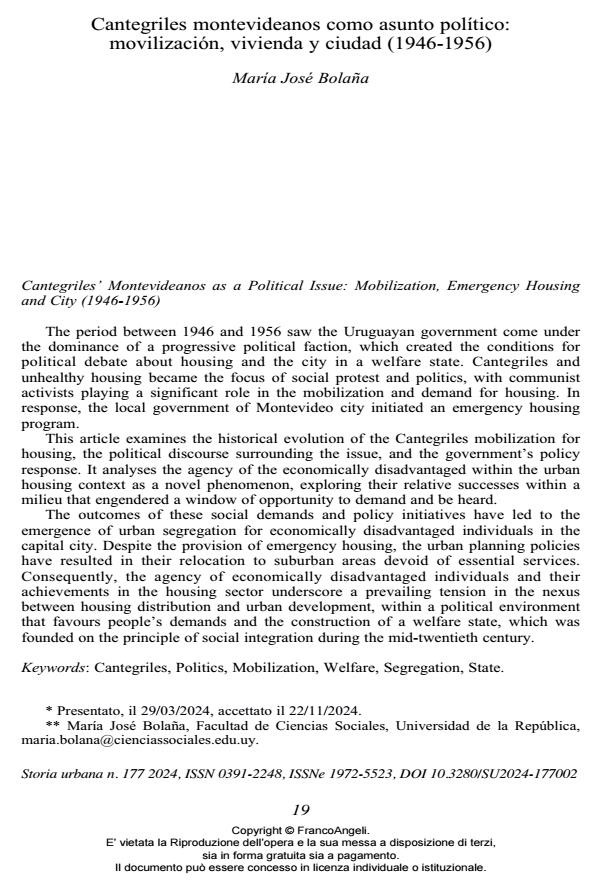Cantegriles’ Montevideanos as a Political Issue: Mobilization, Emergency Housing and City (1946-1956)
Journal title STORIA URBANA
Author/s María José Bolaña
Publishing Year 2025 Issue 2024/177
Language Spanish Pages 20 P. 19-38 File size 149 KB
DOI 10.3280/SU2024-177002
DOI is like a bar code for intellectual property: to have more infomation
click here
Below, you can see the article first page
If you want to buy this article in PDF format, you can do it, following the instructions to buy download credits

FrancoAngeli is member of Publishers International Linking Association, Inc (PILA), a not-for-profit association which run the CrossRef service enabling links to and from online scholarly content.
The period between 1946 and 1956 saw the Uruguayan government come under the dominance of a progressive political faction, which created the conditions for political debate about housing and the city in a welfare state. Cantegriles and unhealthy housing became the focus of social protest and politics, with communist activists playing a significant role in the mobilization and demand for housing. In response, the local government of Montevideo city initiated an emergency housing program. This article examines the historical evolution of the Cantegriles mobilization for housing, the political discourse surrounding the issue, and the government’s policy response. It analyses the agency of the economically disadvantaged within the urban housing context as a novel phenomenon, exploring their relative successes within a milieu that engendered a window of opportunity to demand and be heard. The outcomes of these social demands and policy initiatives have led to the emergence of urban segregation for economically disadvantaged individuals in the capital city. Despite the provision of emergency housing, the urban planning policies have resulted in their relocation to suburban areas devoid of essential services. Consequently, the agency of economically disadvantaged individuals and their achievements in the housing sector underscore a prevailing tension in the nexus between housing distribution and urban development, within a political environment that favours people’s demands and the construction of a welfare state, which was founded on the principle of social integration during the mid-twentieth century.
Dal 1946 al 1956, l’egemonia di una tendenza progressista nel governo uruguaiano creò le condizioni per una discussione politica sull’abitazione e sulla città in un modello statalista e assistenziale. I cantegriles e gli alloggi malsani divennero oggetto della protesta sociale e della politica governativa. I militanti del partito comunista svolsero un ruolo importante nella mobilitazione e nella richiesta di alloggi da parte dei settori più poveri della società. Il governo comunale cercò di rispondere a queste rivendicazioni con una politica di alloggi di emergenza. L’articolo analizza il processo storico della mobilitazione dei cantegriles per le abitazioni, il dibattito politico sul problema all’interno del governo e le soluzioni che furono messe in campo. La agency dei settori popolari per ottenere una soluzione alla questione abitativa urbana e i risultati ottenuti, in un contesto che rappresentò una finestra di opportunità per rivendicare ed essere ascoltati costituisce una argomento finora poco indagato. Tuttavia i risultati delle rivendicazioni sociali e della politica governativa generaro- no l’inizio di un processo di segregazione urbana dei poveri di Montevideo. Anche quando alloggi sociali furono realizzati, questi furono ubicati in aree periferiche prive di servizi. La agency dei settori popolari e le conquiste di questi ultimi in campo abitativo misero in tensione la relazione tra città e distribuzione degli alloggi, in un contesto politico favorevole alle loro richieste e alla costruzione di uno stato sociale basato sull’idea di integrazione sociale.
Keywords: Cantegriles, Politics, Mobilization, Welfare, Segregation, State.
María José Bolaña, Cantegriles montevideanos como asunto político: movilización, vivienda y ciudad (1946-1956) in "STORIA URBANA " 177/2024, pp 19-38, DOI: 10.3280/SU2024-177002